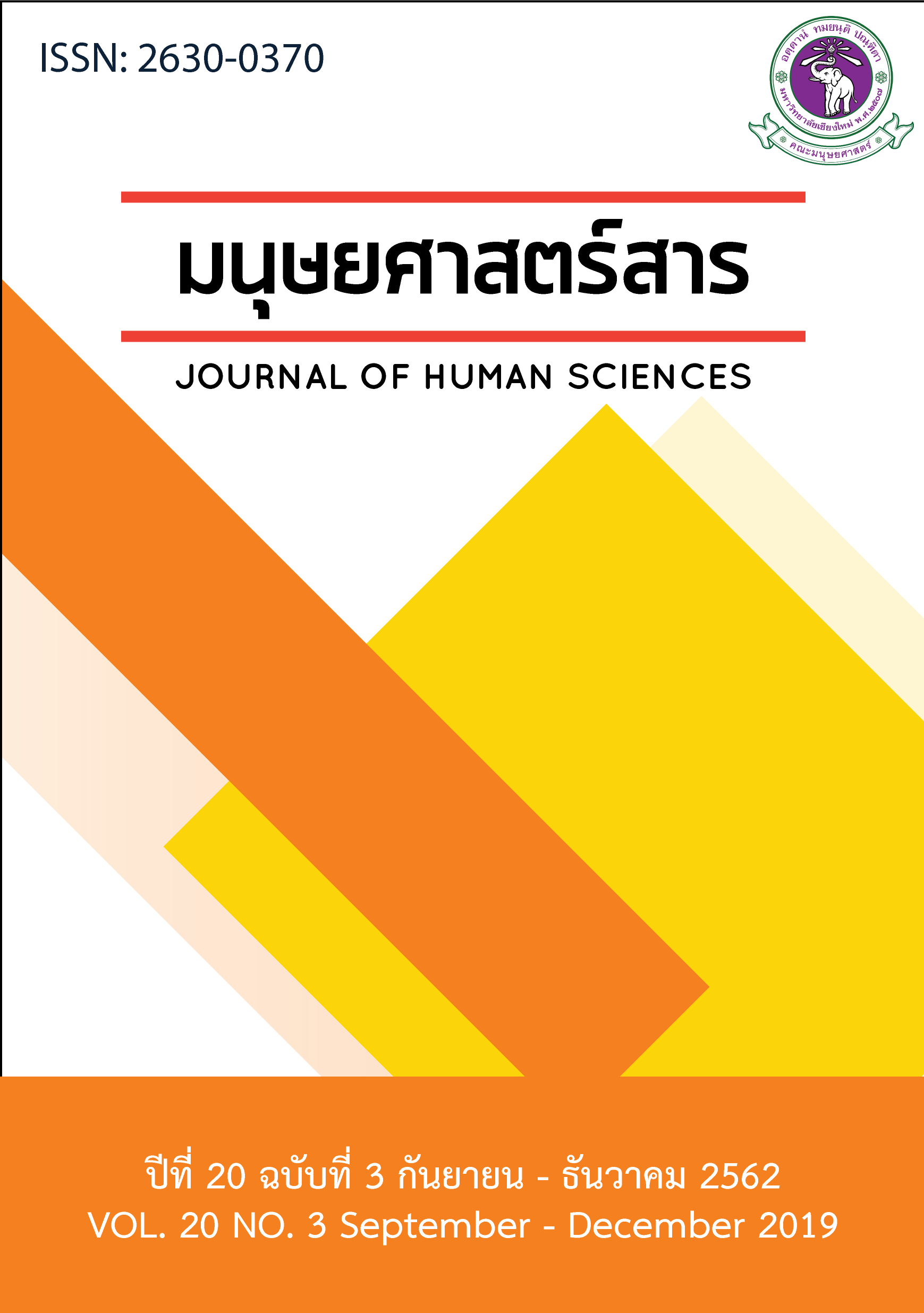หน่วยสร้างกริยาเรียงในวรรณกรรมคร่าวซอ
Main Article Content
บทคัดย่อ
หน่วยสร้างกริยาเรียงในวรรณกรรมคร่าวซอเรื่องหงส์หินมีลักษณะตรงตามกรอบการศึกษาหน่วยสร้างกริยาเรียงทั้ง 6 ลักษณะ ตามแนวคิดหลักของการวิเคราะห์หน่วยสร้างกริยาเรียงของไอเคนวาลด์ คือ องค์ประกอบของหน่วยสร้างกริยาเรียง คุณสมบัติในแง่ประเภททางไวยากรณ์ การมีคุณสมบัติเป็นประโยคเดี่ยว การทำหน้าที่เป็นภาคแสดงในหน่วยสร้าง ผลิตภาวะ และจำนวนคำกริยาที่อาจปรากฏ ส่วนเงื่อนไขของการเกิดของหน่วยสร้างกริยาเรียงในประโยคจากคร่าวซอเรื่องหงส์หินพบว่า ไม่อนุญาตให้มีคำเชื่อมใด ๆ ปรากฏระหว่างคำกริยาในหน่วยสร้าง ผลการศึกษาที่พบยังแสดงให้เห็นว่าลักษณะคำกริยาทุกคำในหน่วยสร้างในวรรณกรรมคร่าวซอหงส์หินมีกาล การณ์ลักษณะ มาลา ขั้วบอกเล่า-ปฏิเสธร่วมกัน และให้มีข้อค้นพบที่สำคัญอย่างน้อย 1 ข้อค้นพบที่สำคัญร่วมกัน มีทำนองเสียงหรือระดับเสียงสูงต่ำในคำแบบเดียวกับประโยคความเดียว และไม่มีช่วงหยุดระหว่างคำกริยา โดยแสดงเหตุการณ์เพียงเหตุการณ์เดียวที่ซับซ้อน นอกจากนั้น หน่วยสร้างกริยาเรียงในวรรณกรรมดังกล่าวยังมีลักษณะต่อเนื่อง แสดงให้เห็นถึงความตรึงแน่นในการเรียงต่อเนื่องมากน้อยที่แตกต่างกัน
Article Details
เอกสารอ้างอิง
Aikhenvald, A. (2006). Serial Verbs Constructions. New York: Oxford University Press.
Christaller, J. G. (1875). A Grammar of the Asante and Fante Language Called Tshi. Basel: n.p.
Chuwichaya, Y. (1993). khwampen prayok khong nuai sang kriya riang nai phasa Thai [Clause hood In Serial Verb Constructions in Thai]. (Doctoral thesis, Chulalongkorn University)
Filbeck, D. (1975). A Grammar of Verb Serialization in Thai. in Studies in Thai Linguistics in Honor of William J. Gedney, (eds.) by Jimmy G. Harris and James R. Chamberlain (eds.) Bangkok: Central.
Harabutra, C. (1997). kansưksa khwamsamphan khong kham kriya song kham thi riang kan nai prayok phasa Thai [A study of Two-verb concatenation in Thai sentences]. (Master’s thesis, Chulalongkorn University.)
Iwasaki, S. (1989). Clause hood and Verb Serialization in Thai Narrative. Journal of Language and Linguistics, 7(2). 84-130.
Office of the Royal Society. (2013). The Royal Institute Dictionary of 2011. Bangkok: Nanmeebook.
Panthumetha, N. (1967). khrongsang khong nuai kæn khong kriya wali
[The Structure of the core, a Verb Phrase Constituent]. (Master’s thesis, Chulalongkorn University.)
Rung-Ruengsri, U. (1981). Khrâ:wsɔ:Honghin. Chiangmai: Faculty of Humanities, Chiang Mai University.
Sereecharoensatit, T. (1984). Conjunct Verbs and Verbs – in – Series in Thai. (Ph.D Dissertation, University of Illinois).
Seuren, P. (1990). Serial Verb Constructions. When Verbs Collide: Papers from the (1990) Ohio State.
Stewart, J.M. (1963). Some Restrictions on Objects in Twi. Journal of West African Language. 145-149.
Takahashi, K. (1996). Negation in Thai basic serial verb constructions. (Master’s thesis, Chulalongkorn University)
Thepkanjana, K. (1986). Serial Verb Constructions in Thai. (Ph.D dissertation, University of Michigan).
Westermann, D. (1930). A Study of the Ewe Language. London: Oxford University Press.
Wilawan, S. (1993). A Reanalysis of So – called Serial Verb Constructions in Thai Khmer Mandarin Chinese and Yoruba. (Ph.D Dissertation, University of Hawaii).


